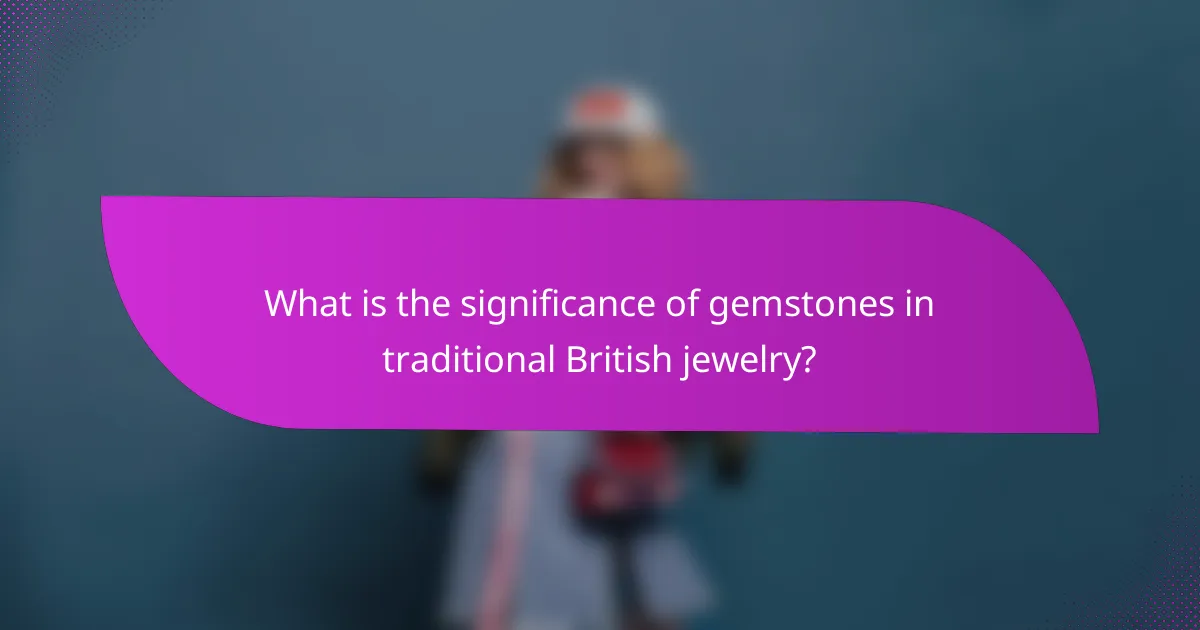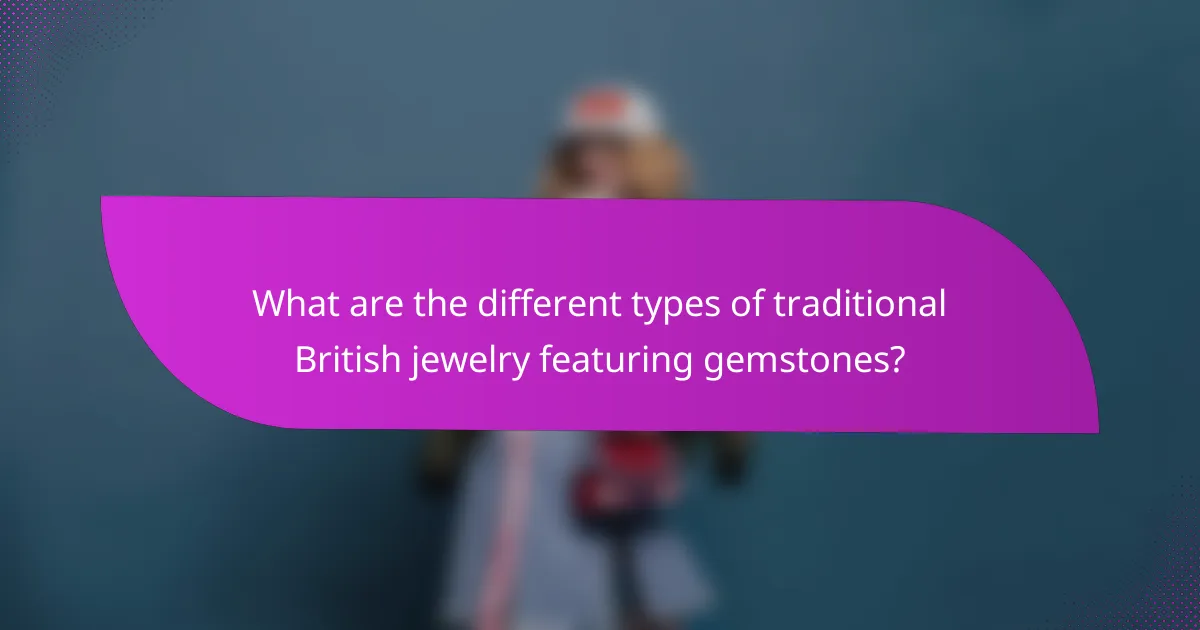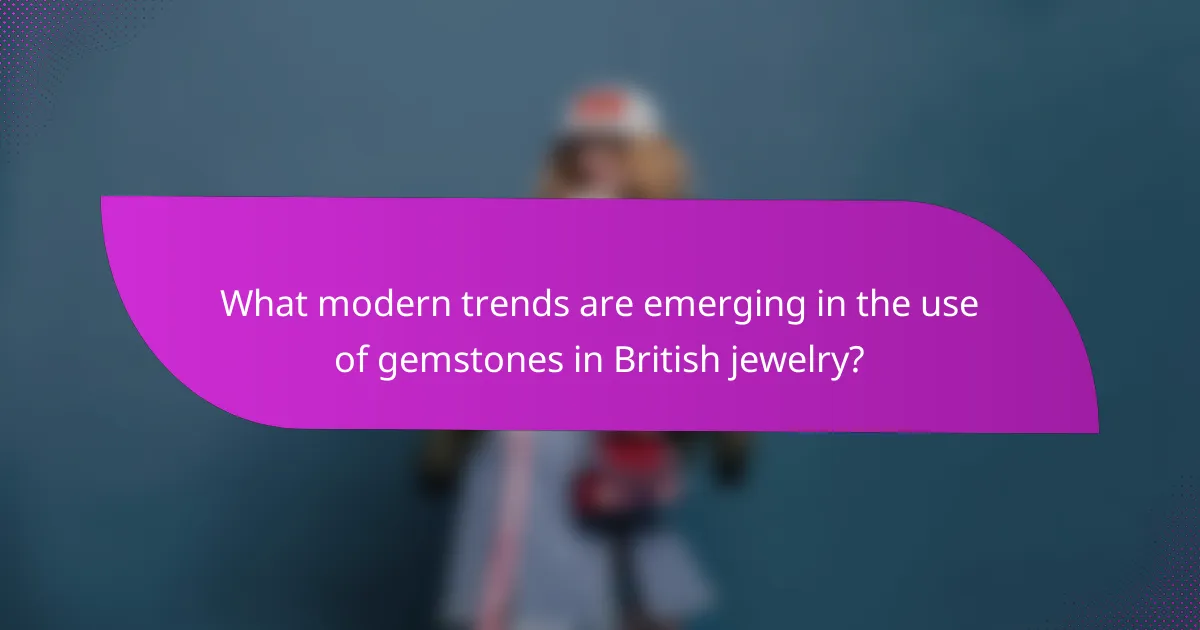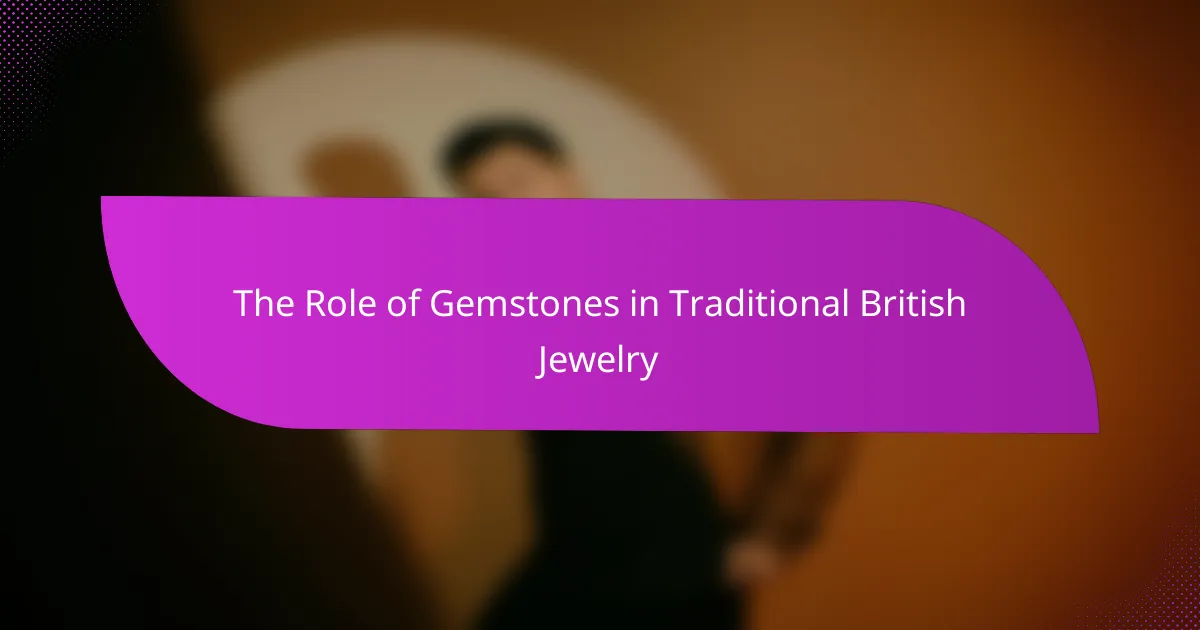Gemstones are integral to traditional British jewelry, symbolizing status, wealth, and cultural heritage. Historically, they have adorned royal regalia, including the British Crown Jewels, and are associated with specific meanings such as love and protection. Various types of jewelry, such as signet rings, brooches, earrings, necklaces, and cufflinks, showcase the craftsmanship and significance of gemstones. Modern trends emphasize sustainable and ethically sourced stones, with a growing interest in unique and vintage gemstones, reflecting both innovation and tradition in contemporary design.

What is the significance of gemstones in traditional British jewelry?
Gemstones hold significant cultural and historical value in traditional British jewelry. They symbolize status, wealth, and heritage. Throughout history, gemstones have been used in royal regalia and ceremonial pieces. For instance, the British Crown Jewels feature numerous precious stones, signifying royal authority. Additionally, gemstones are often associated with specific meanings and attributes, such as love or protection. The use of particular stones, like sapphires and emeralds, reflects the preferences of different historical periods. This tradition continues today, influencing modern jewelry design and craftsmanship.
How have gemstones been historically used in British jewelry?
Gemstones have historically been used in British jewelry as symbols of status and wealth. Throughout the centuries, various gemstones have adorned royal and noble adornments. For example, during the Tudor period, gemstones like diamonds and rubies were popular among the monarchy. The Victorians favored intricate designs featuring garnets and amethysts. These stones were often set in gold or silver, enhancing their visual appeal. Gemstones also held symbolic meanings, such as sapphires representing loyalty. The use of gemstones in British jewelry reflects cultural trends and social hierarchies over time. Historical records indicate that gemstones were often passed down through generations, signifying heritage and tradition.
What are the most popular gemstones in traditional British jewelry?
The most popular gemstones in traditional British jewelry include diamonds, sapphires, emeralds, and rubies. Diamonds are often used in engagement rings and royal jewelry. Sapphires are favored for their rich blue color and historical significance. Emeralds are valued for their vibrant green hue and rarity. Rubies are prized for their deep red color and association with passion. These gemstones have been featured in iconic pieces, including royal crowns and heirlooms, reflecting their enduring popularity in British culture.
How do cultural influences shape the use of gemstones in British jewelry?
Cultural influences significantly shape the use of gemstones in British jewelry. Historical events, such as the British Empire’s expansion, introduced diverse gemstones from around the world. This exposure led to the incorporation of stones like diamonds from India and emeralds from Colombia into British designs. Additionally, Victorian mourning jewelry popularized the use of black gemstones, like onyx and jet, reflecting societal customs around death. The Arts and Crafts movement emphasized natural materials, resulting in a preference for locally sourced stones. Today, contemporary British jewelry often blends traditional and modern influences, showcasing both cultural heritage and innovative designs. The ongoing fascination with royal gemstones also drives trends, as seen in pieces inspired by royal engagements and historical artifacts.
Why are gemstones important in the context of British jewelry craftsmanship?
Gemstones are crucial in British jewelry craftsmanship due to their aesthetic appeal and cultural significance. They enhance the beauty of jewelry pieces, making them more desirable to consumers. British jewelers often use gemstones to showcase their skills and artistry. Historically, gemstones have been symbols of status and wealth in British society. For instance, the Crown Jewels feature numerous precious stones that represent royal heritage. The use of local gemstones, like Welsh gold, connects craftsmanship to national identity. Additionally, gemstones contribute to the uniqueness of each piece, as no two stones are alike. This individuality appeals to collectors and enthusiasts alike. Overall, gemstones are integral to the legacy and evolution of British jewelry craftsmanship.
What techniques are used in setting gemstones in traditional British jewelry?
Traditional British jewelry employs several techniques for setting gemstones. Common methods include claw setting, bezel setting, and pavé setting. Claw setting involves metal prongs that hold the gemstone securely while allowing light to enter. Bezel setting encases the gemstone in a metal rim, offering protection and a sleek appearance. Pavé setting features small gemstones set closely together, creating a continuous sparkle. These techniques highlight the craftsmanship and aesthetic appeal of traditional British jewelry. Historical records indicate that these methods have been used for centuries, showcasing their enduring popularity and effectiveness.
How do gemstones enhance the aesthetic appeal of jewelry pieces?
Gemstones enhance the aesthetic appeal of jewelry pieces by adding color, brilliance, and uniqueness. Their diverse range of hues allows for creative expression in design. Gemstones can reflect light in various ways, creating a captivating sparkle. This optical phenomenon is due to their refractive properties, which differ among types. Unique shapes and cuts of gemstones contribute to the overall design, making each piece distinctive. Historical significance also plays a role; certain gemstones are associated with cultural meanings and traditions. For instance, sapphires symbolize nobility and wisdom, while emeralds represent rebirth. The combination of these attributes makes gemstones essential in elevating the visual allure of jewelry.

What are the different types of traditional British jewelry featuring gemstones?
Traditional British jewelry featuring gemstones includes several types. Notable examples are signet rings, which often display family crests or initials. Another type is the brooch, frequently adorned with various gemstones. Earrings, especially those featuring pearls or colored stones, are also common. Necklaces, including lockets and pendants, often incorporate gemstones for added elegance. Additionally, gemstone-studded tiaras were historically worn by nobility. Cufflinks made with gemstones are popular accessories for formal attire. Each type of jewelry showcases the craftsmanship and cultural significance of gemstones in British tradition.
What are the key styles of traditional British jewelry that incorporate gemstones?
Key styles of traditional British jewelry that incorporate gemstones include the Victorian, Edwardian, and Art Deco styles. The Victorian style features intricate designs with a variety of gemstones like garnets and pearls. Edwardian jewelry is known for its elegance, often using diamonds and sapphires. Art Deco pieces are characterized by geometric shapes and bold colors, frequently incorporating emeralds and rubies. Each style reflects the era’s aesthetic values and craftsmanship. Historical records show that these styles were popular among the British aristocracy, influencing modern jewelry design.
How do different styles reflect the use of specific gemstones?
Different styles of traditional British jewelry showcase specific gemstones through unique design elements. For example, Art Deco style often features bold geometric shapes and uses gemstones like diamonds and emeralds for their clarity and brilliance. Victorian jewelry, on the other hand, frequently incorporates gemstones such as garnets and pearls, reflecting romantic and sentimental themes.
The Edwardian era emphasizes delicate filigree work and utilizes diamonds and sapphires to convey elegance and sophistication. Each style not only highlights the visual appeal of the gemstones but also their symbolic meanings. For instance, the use of turquoise in Arts and Crafts jewelry symbolizes protection and healing, aligning with the movement’s focus on natural materials.
These design choices are influenced by cultural trends and historical contexts, showcasing the versatility and significance of gemstones in British jewelry. The specific use of gemstones in various styles illustrates their importance in expressing personal identity and social status throughout history.
What role do gemstones play in royal and ceremonial jewelry?
Gemstones play a significant role in royal and ceremonial jewelry by symbolizing power, status, and heritage. They are often used to enhance the visual appeal of these pieces. Historically, gemstones have been associated with specific meanings and virtues. For example, rubies represent courage, while sapphires symbolize wisdom. Royal families often select gemstones based on their historical significance and personal preferences. The Crown Jewels of the United Kingdom feature numerous gemstones, showcasing their importance in royal ceremonies. These jewels are not only ornamental but also serve as national symbols. The presence of gemstones in ceremonial jewelry reflects the wealth and prestige of the monarchy.
How do gemstones vary across different regions of Britain?
Gemstones vary significantly across different regions of Britain. Each area is known for specific types of gemstones due to geological differences. For example, Scotland is famous for its agate and granite, particularly from the Isle of Skye. Wales is renowned for its rare blue stones, such as the Lapis Lazuli and the unique Welsh gold. In England, the Peak District is known for its fluorite, while Cornwall is noted for its tourmaline and beryl. Northern Ireland has a rich supply of limestone, which sometimes contains gemstones like calcite. These regional variations contribute to the unique characteristics of traditional British jewelry.
What are the unique gemstone preferences in Scottish jewelry?
Scottish jewelry uniquely favors gemstones like amethyst, citrine, and agate. Amethyst is often associated with Scottish heritage and is the national gemstone. Citrine is valued for its warm hues and is used in various traditional pieces. Agate is frequently incorporated into Scottish brooches and pendants. These gemstones reflect Scotland’s natural landscape and cultural history. The use of these stones dates back centuries, showcasing their importance in Scottish craftsmanship.
How does Welsh jewelry incorporate local gemstones?
Welsh jewelry incorporates local gemstones by featuring materials such as gold, silver, and unique stones like Welsh slate and Lapis Lazuli. The use of these local gemstones reflects the natural beauty and heritage of Wales. Artisans often craft pieces that highlight the colors and textures of these stones. For example, Welsh slate is commonly used in rings and pendants. This practice connects the jewelry to Welsh culture and landscape. Additionally, the incorporation of local gemstones supports regional craftsmanship. Many jewelers source materials locally to maintain authenticity. This tradition enriches the jewelry with a sense of place and identity.

What modern trends are emerging in the use of gemstones in British jewelry?
Modern trends in British jewelry increasingly emphasize sustainable and ethically sourced gemstones. Consumers are increasingly prioritizing transparency in sourcing. This shift reflects a growing awareness of environmental and social issues. Additionally, there is a rise in the popularity of unique and rare gemstones. Designers are incorporating unconventional stones to create distinctive pieces. Customization is also trending, allowing consumers to personalize their jewelry. Furthermore, vintage and antique gemstones are being repurposed in contemporary designs. This trend connects modern aesthetics with historical significance. Overall, these trends highlight a blend of innovation and tradition in British jewelry design.
How are contemporary jewelers reinterpreting traditional gemstone use?
Contemporary jewelers are reinterpreting traditional gemstone use by incorporating innovative designs and modern techniques. They often blend traditional gemstones with unconventional materials, creating unique pieces. Many jewelers are also focusing on ethical sourcing of gemstones, reflecting consumer demand for sustainability. Additionally, contemporary designs often emphasize personalization, allowing for customizations based on individual tastes. This shift also includes the use of alternative gemstones, which challenge the dominance of classic choices like diamonds. Furthermore, contemporary jewelers frequently explore historical styles while infusing modern aesthetics. For example, vintage-inspired pieces are reimagined with a fresh twist. This approach not only honors traditional craftsmanship but also engages a new generation of jewelry enthusiasts.
What innovative techniques are being employed with gemstones today?
Innovative techniques employed with gemstones today include laser cutting and 3D printing. Laser cutting allows for precise shaping and intricate designs. This technique enhances the aesthetic appeal of gemstones. 3D printing creates custom settings and designs that were previously impossible. These methods reduce waste and increase efficiency in gemstone processing. Additionally, advancements in synthetic gemstones have made high-quality alternatives more accessible. These innovations cater to modern consumer preferences for unique and sustainable jewelry options.
How do sustainability concerns influence gemstone sourcing in modern jewelry?
Sustainability concerns significantly influence gemstone sourcing in modern jewelry. Many consumers prioritize ethically sourced materials. This demand encourages jewelers to adopt sustainable practices. For instance, some brands now use lab-grown gemstones. These alternatives reduce environmental impact and ethical dilemmas. Additionally, traceability in supply chains has become crucial. Jewelers seek certifications that verify responsible sourcing. According to a 2021 report by the Responsible Jewelry Council, 75% of consumers prefer brands with sustainable practices. This shift shapes the industry’s approach to sourcing gemstones.
What tips should consumers consider when purchasing gemstone jewelry?
Consumers should consider authenticity when purchasing gemstone jewelry. Verify the gemstone’s certification from recognized gemological laboratories. Look for information regarding the gemstone’s origin and treatment history. Evaluate the quality based on the four Cs: cut, color, clarity, and carat weight. Compare prices across different retailers to ensure fair market value. Inspect the craftsmanship of the jewelry setting and overall design. Consider personal preferences regarding style and durability. Lastly, inquire about return policies and warranties for added security.
How can one ensure the quality and authenticity of gemstones in jewelry?
To ensure the quality and authenticity of gemstones in jewelry, one should seek certification from reputable gemological laboratories. These laboratories provide detailed reports that confirm the gemstone’s identity, quality, and any treatments it may have undergone. Additionally, examining the gemstone under magnification can reveal inclusions and characteristics unique to natural stones. Knowledge of the Four Cs—cut, color, clarity, and carat weight—also helps assess a gemstone’s value. Purchasing from established jewelers with a good reputation further ensures authenticity. According to the Gemological Institute of America (GIA), certified gemstones maintain higher resale value and consumer trust.
What are the best practices for caring for gemstone jewelry?
To care for gemstone jewelry, clean it regularly using a soft cloth. Avoid harsh chemicals that can damage the stones. Store gemstones separately to prevent scratching. Keep them in a cool, dry place away from direct sunlight. Remove jewelry before engaging in physical activities to prevent wear. Have gemstones professionally inspected and cleaned periodically. These practices help maintain the jewelry’s appearance and longevity. Proper care can significantly extend the life of gemstone pieces, ensuring they remain vibrant and intact.
The main entity of the article is gemstones in traditional British jewelry. The article explores the cultural and historical significance of gemstones, their use in royal and ceremonial pieces, and the various techniques employed in their setting. It highlights popular gemstones such as diamonds, sapphires, emeralds, and rubies, while examining how regional variations and historical styles influence their incorporation into jewelry. Additionally, the article addresses modern trends in gemstone sourcing and craftsmanship, emphasizing sustainability and innovative techniques. Key considerations for consumers when purchasing gemstone jewelry, including authenticity and care practices, are also discussed.
